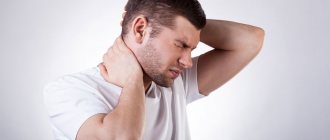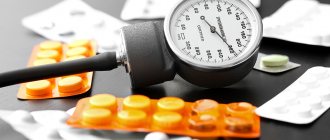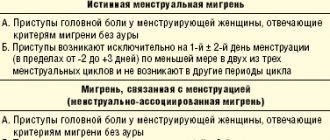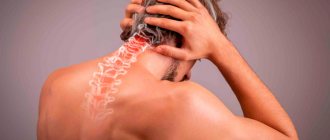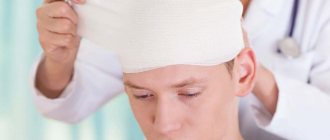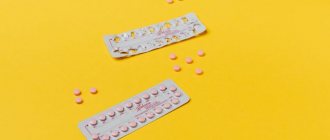Table of contents
Relieve tension Change contraceptive method Check your vision Primary or secondary headache? Sources
Headache can be caused by stress, fatigue, taking oral contraceptives, overstrain of the eye muscles with incorrectly selected glasses or lenses, a jump in blood pressure, dysfunction of the temporomandibular joint, which in turn leads to secondary tension in the cervical-occipital muscles, causing tension in the aponeurosis, and many other reasons.
One of the common triggers of headaches can be anemia, leading to chronic pain syndrome.
It happens that there is no painkiller at hand or it is impossible to use: the pain is caused by a side effect of another drug, the patient fundamentally avoids taking pills, the medicine cannot be taken due to pregnancy or lactation. How to relieve a headache in this case?
Causes of migraines that you don't know about
Causes of migraines that you don't know about
To heal your head, start with the intestines.
The gastrointestinal tract is as important to your body as roots are to a tree: it nourishes all systems in the same way. Therefore, it is important to know what the intestines can signal to us.
What foods and substances pass through your intestines regularly? How does the immune system react to them?
A specific reaction of the immune system to certain types of food can cause migraines. Testing for immunoglobulins E and G, which the body produces in response to antigens in food, can help determine the types of mediated immune reactions. Although study results vary, one randomized crossover study of migraine sufferers found that dietary restriction to eliminate immunoglobulin G antibodies was an effective strategy for controlling migraine attacks.
A recent study published in the journal Headache (2013) assessed the benefits of a diet eliminating immunoglobulin G antibodies in patients with irritable bowel syndrome. The researchers concluded that such dietary adjustments could reduce the frequency of attacks of both diseases, as well as positively affect the quality of life of patients and their health.
Can other types of food trigger migraine symptoms?
An example of this would be the histamine reaction. The natural presence of histamine in food, along with other vasoactive (or biogenic) amines, explains why some migraine sufferers experience relief after taking antihistamines. Foods high in histamine include aged cheeses, red wine, smoked/dried fish and meats, spinach, eggplant and yeast.
Foods that cause a histamine reaction include chocolate, egg whites, shellfish, strawberries, tomatoes, fish, pork and citrus fruits. Another vasoactive amine is tyramine, which is found in fermented sauces (such as soy sauce), smoked/cured fish and meats, sauerkraut, some beers, aged cheeses and chicken livers. In addition, caffeine, food additives - monosodium glutamate, sulfites, nitrites - or similar substances can cause a migraine attack. How can you determine which gut or metabolic factors are affecting your body?
Comparative stool analysis is an ideal way to determine treatment: it helps to assess imbalances in markers of digestion and absorption of food, inflammatory/immune status and the state of intestinal microflora. In addition, it is necessary to check the activity of Helicobacter pylori
bacterium that causes peptic ulcers of the stomach and duodenum). Active Heliobacter pylori is directly related to migraine flare-ups and attack frequency. Healing Heliobacter pylori significantly relieves headaches.
Are the nutrients found in healthy foods and supplements absorbed or excreted by the body?
Certain nutrients, such as vitamin B2 and coenzyme Q10, have proven to be excellent headache relievers. Decreased levels of nutrients, especially magnesium, are also associated with migraine. An overall nutritional status assessment will help assess how much you need in magnesium, vitamin B2 and coenzyme Q10, as well as antioxidants, other B-complex vitamins, fat-soluble vitamins, amino acids, digestive aids and fatty acids.
Hormonal factors
Women are more susceptible to migraines than men. Periods cause headaches for 60% of women who suffer from migraines. According to the Migraine Research Foundation, only 5% of women over 60 continue to experience headaches. Checking your hormonal levels before menopause can help determine the cause of your migraines. Saliva analysis is the most convenient way to find out the level of estradiol, progesterone and testosterone during the monthly cycle. By the way, histamine may also be involved in this: it has been found that it can stimulate the synthesis of estradiol. An imbalance of adrenal hormones, often caused by stress, reduces resistance to migraines. Given these data, diagnostics that evaluate adrenal hormones (such as cortisol and DHEA) can determine the true cause of the disease. Finally, levels of melatonin, a hormone secreted by the pineal gland, may also help combat migraines. A recent review of the pain-relieving properties of melatonin noted that melatonin has been used effectively to relieve pain symptoms in conditions such as fibromyalgia, irritable bowel syndrome, migraines, and cluster headaches.
Let's summarize.
While there are many reasons why people may suffer from migraines, the best first step in headache management is to identify and address the triggers and assess the impact of the gut on overall body health. General recommendations are:
· Eat regularly: Meals and snacks throughout the day will help stabilize your blood sugar levels.
· Drink more water to avoid dehydration.
· Sleep 8 hours a day, not occasionally, but every day.
· Develop a stress management plan.
· Write down when and under what circumstances you experienced a headache attack so that you can then identify the triggering factors.
In addition to these measures, it is recommended to undergo studies that can shed light on the possible causes of the disease and help your doctor choose a treatment method. Complexes of research that may be useful:
— blood test for antibodies to the food panel, — assessment of nutritional status, — comparative stool analysis, — saliva test for hormones.
Relieve tension
Tension headaches are a common problem for people whose jobs involve high levels of concentration, responsibility, and stress.
The prevalence of this type of pain in the world ranges from 46 to 78%. Statistically, tension headaches lead to more missed work days than migraines. There are three categories of tension headaches: infrequent episodic, frequent episodic and chronic. Doctors usually advise treating headaches with over-the-counter analgesics. However, with frequent and chronic pain, medications soon stop helping.
Massage helps treat headaches. Scientists conducted an experiment: over the course of 4 weeks, they conducted four treatment sessions for participants in two groups. For the first group, therapy included massage and manipulation of the cervical spine, for the second group - only massage. 8 weeks after the experiment, participants in both groups showed significant improvement in performance.
A course of relaxing massage, gentle manual practices, and osteopathic techniques can be an effective method of reducing the frequency and intensity of headaches. But if this is not possible, then an independent head massage will help relieve the spasm that is causing the problem.
Cervical exercises can also help situationally: bending and turning the neck will improve blood circulation and reduce the intensity of pain.
But you should be careful with circular movements, they can provoke spinal tension.
If the pain is caused by mild stress or fatigue, you can use breathing practices, meditation and other methods that reduce arousal.
Migraine treatment
First aid for migraines at home
involves taking painkillers that will help stop a migraine attack and improve the patient’s well-being. However, in the future, preventive treatment is carried out, the effect of which can reduce the frequency of attacks, their duration and intensity, and improve the patient’s quality of life.
First aid for migraines
includes taking the following medications:
- nonsteroidal anti-inflammatory drugs (ibuprofen, diclofenac, indomethacin, ketoprofen);
- triptans have a vasoconstrictor effect, eliminate;
- paracetamol;
- solpadeine (a strong painkiller containing codeine);
- antiemetic drugs.
For persistent migraine attacks (4-6 or more attacks per month), accompanied by a prolonged aura, signs of muscle weakness and numbness, or in the absence of effect after taking analgesics, the following medications are prescribed (in the absence of contraindications):
- beta-blockers – eliminate spasm of pial vessels (located in the brain);
- calcium antagonists (slow calcium channel blockers);
- antiepileptic drugs;
- antidepressants.
Of particular importance is the correction of lifestyle, the elimination of negative factors, and the prevention of the development of migraine attacks. Drug treatment is prescribed by the doctor depending on the type of migraine, the presence of aura and other features.
The diet is adjusted - meat, yeast, marinades, sugar, chocolate, sweets, and alcohol are excluded from the diet. The daily diet should be varied with fresh fruits and vegetables, cottage cheese and fermented milk products. Meals should be balanced, five times a day and in small portions.
To prevent migraine attacks, avoid excessive physical activity, stress and fatigue, lack of sleep or excess (a healthy night's sleep lasts 8 hours). It is recommended to wear sunglasses when going outside. Drug treatment, lifestyle correction, and exclusion of trigger factors can significantly improve the patient’s condition.
You can make an appointment with specialists with extensive clinical experience by calling. (343) 355-56-57
Change your contraceptive method
In some cases, if you have a headache, it should be treated not by prescribing medications, but, on the contrary, by stopping taking them.
For example, patients suffering from migraine with aura should avoid taking combined oral contraceptives due to the high risk of ischemic stroke due to their ability to provoke thrombogenesis. For women suffering from severe headaches and migraines without aura, the risks are lower, but for them exogenous hormones and estrogen withdrawal may also be triggers.
Therefore, if you notice that after starting to take oral contraception, headaches have become more frequent and intense, this is a reason to think about changing your method of preventing pregnancy.
Disease prevention
For prevention purposes, it is necessary to make adjustments to the patient’s lifestyle. It is necessary to give up alcohol (especially drinking red wine, beer and champagne) and smoking, play sports, adjust your diet, protect yourself from stress and overwork, and take a walk every day.
Along with measures to relieve acute attacks, there are a number of actions to prevent their occurrence. These include the use of herbal infusions; applying cooling and warming compresses, using essential oils; massage; medicinal baths.
Primary or secondary headache?
Headaches are divided into primary and secondary.
Primary headaches have no structural or metabolic cause. It is mild pain of this type that can be relieved with relaxation, massage, walking in the fresh air, and so on. These also include tension headaches, migraines, cluster headaches, and analgesic rebound headaches. Secondary headaches are caused by conditions such as increased intracranial pressure, pseudotumor cerebri, subdural or intracerebral hematomas, hypertension, meningitis, temporal arteritis, Lyme disease, and brain tumors.
An accurate diagnosis and identification of the causes of headache largely determine the success of its treatment.
Therefore, if you experience frequent, intense or chronic headaches, you need to be examined by a specialist. In this case, it is better to start with a visit to a neurologist and ophthalmologist.
How to treat migraine at home using traditional methods
Migraine is a common condition in which blood flow to one part of the brain is disrupted. A vascular spasm occurs, which practically immobilizes the person. These pains occur both on their own and accompany other painful conditions: allergic reactions, poisoning, malfunctions of the hormonal system.
To find out how to treat this disease or at least alleviate suffering, let’s turn to proven traditional medicine. This treatment involves a comprehensive approach, which includes:
Sources:
- Scripter C. Headache: Tension-Type Headache. FP Essent. 2018 Oct;473:17-20. PMID: 30346680.
- Espí-López GV, Zurriaga-Llorens R, Monzani L, Falla D. The effect of manipulation plus massage therapy versus massage therapy alone in people with tension-type headache. A randomized controlled clinical trial. Eur J Phys Rehabil Med. 2021 Oct;52(5):606-617. Epub 2021 Mar 18. PMID: 26989818.
- Marks DR, Rapoport AM. Practical evaluation and diagnosis of headache. Semin Neurol. 1997;17(4):307-12. doi: 10.1055/s-2008-1040943. PMID: 9474710.
- MacGregor E.A. Contraception and headache. Headache. 2013 Feb;53(2):247-76. doi: 10.1111/head.12035. PMID: 23432442.
- Allais G, Gabellari IC, De Lorenzo C, Mana O, Benedetto C. Oral contraceptives in migraine. Expert Rev Neurother. 2009 Mar;9(3):381-93. doi: 10.1586/14737175.9.3.381. PMID: 19271947.
- Friedman DI. Headache and the eye. Curr Pain Headache Rep. 2008 Aug;12(4):296-304. doi:10.1007/s11916-008-0050-1. PMID: 18625108.
Published on the portal health.mail.ru
Causes of migraine
Migraine headaches are caused by changes in the lumen of blood vessels in the skin and muscles of the head. The vessels first contract and then expand sharply. The phenomena of aura are associated with a similar two-phase change in the lumen of the carotid artery, which supplies the brain. Modern research notes that migraine attacks occur against the background of increased activity of the brain and autonomic systems. After an attack, the state of these systems returns to normal. Migraine is typical for people engaged in mental work. Among people whose activities involve constant physical activity, migraine practically does not occur.
Meanwhile, the mechanism of migraine has not yet been fully studied. Factors that increase the risk of seizures
, are:
- heredity;
- low resistance to stress, mental imbalance, tendency to depression;
- chronic fatigue;
- smoking;
- diabetes;
- in women – menstruation, pregnancy, menopause;
- taking hormonal drugs.
Factors that are the “trigger mechanism” of an attack are separately identified:
- psycho-emotional stress (stress, strong emotional arousal);
- strong physical activity;
- weather changes (atmospheric pressure fluctuations);
- lack of sleep or, conversely, excessive sleep;
- alcohol (red wine is highlighted);
- some types of products (chocolate, hard cheeses, smoked meats, coffee, fish).
Medicines for migraines and other headaches
For headaches (with migraine and not associated with migraine), the doctor may prescribe any drugs from the group of NSAIDs - non-steroidal anti-inflammatory drugs. All medications in this group relieve headaches by stopping inflammation of the vascular wall. Moreover, some NSAIDs contain not only an analgesic component (painkiller), but also additional substances - for example, sedatives or antispasmodics (relieving spasms).
Based on the presence or absence of these additional substances, these drugs are divided into:
- one-component
- multicomponent (combined).
Single-component include drugs containing only the NSAID itself, for example:
- acetylsalicylic acid - Aspirin, Upsarin, etc. To relieve an attack, a single dose of 500 mg or more is usually prescribed.
IMPORTANT! Effervescent tablets are absorbed faster, so if you have a migraine, it is better to take them, especially if the attack is accompanied by nausea.
IMPORTANT! Drugs for the prevention of strokes and heart attacks containing acetylsalicylic acid (Trombo ACC, Cardiomagnyl, Aspirin Cardio, etc.) are not suitable for our purposes, since the dosage of the active substance in them is very low.
- acetaminophen (paracetamol) - Paracetamol, Efferalgan, Panadol, etc. It must be said that in order to combat migraines, paracetamol itself is not very effective, so it is better to pay attention to combination drugs containing it;
- ibuprofen - Ibuprofen, Nurofen, Brufen, etc. - as in the case of acetylsalicylic acid, the doctor may prescribe 500 mg or more of ibuprofen per dose to relieve migraine headaches;
- metamizole sodium - Baralgin, Analgin. IMPORTANT! It is undesirable to constantly take metamizole sodium preparations, since this substance can change the composition of the blood and also negatively affects the liver and kidneys;
- naproxen – Nalgesin, Naproxen. A popular remedy among people suffering from migraines, naproxen preparations are available both single-component and combined, and the average dosage for attacks is usually 500–750 mg;
- diclofenac – Diclofenac, Voltaren, etc.
- ketorolac (Ketanov) and lornoxicam (Xefocam) are very powerful analgesics. They, like some of the above drugs (for example, Baralgin), can be prescribed by a doctor for migraines not only in tablet form, but also in the form of injections.
In addition, if during a migraine attack the patient experiences severe nausea, an anesthetic drug from the NSAID group can also be prescribed in the form of suppositories used rectally - for example, Cefekon D with paracetamol, Indomethacin with indomethacin, Voltaren with diclofenac, etc.).
* * *
Among the multicomponent (combined) painkillers that are often used to relieve migraine attacks and headaches of other origins are:
- Askofen, Citramon - drugs with approximately the same content of acetylsalicylic acid, paracetamol and caffeine. IMPORTANT! To relieve migraine attacks, the doctor prescribes these medications only to those patients who do not have a tendency to vascular spasms and increased blood pressure (this is due to the caffeine content in both drugs).
- Pentalgin - however, it can be used for migraines only in consultation with a doctor. The fact is that different types of this medicine have different compositions and if, for example, Pentalgin ICN can alleviate an attack, then “ordinary” Pentalgin will not bring any benefit for migraines. By the way, the drugs Sedal-M and Sedalgin Neo have a composition similar to Pentalgin ICN.
- Tempalgin, which contains metamizole sodium (which we already discussed above and recommended not to take it regularly due to dangerous side effects).
- Spazmalgon - like Tempalgin, it also contains metamizole sodium, so the precautions should be identical.
- Andipal - in addition to metamizole sodium, contains phenobarbital - a substance that quickly becomes addictive.
Triptans for migraines
In addition to the listed “broad-spectrum” painkillers, special analgesics specifically against migraine are also available on the pharmaceutical market.
It is known that many people suffering from migraines, even with the help of a qualified specialist, cannot choose for themselves a truly effective painkiller from the NSAID group. But in the late 80s of the last century, the first special medicine against migraine, Sumatriptan, was developed in Germany. Under its influence, the vessels dilated during a migraine attack narrow, and therefore it is sumatriptan that still acts as the “gold standard” in the treatment of migraine. It belongs to the triptan , which was later replenished with several more similar substances, each of which can significantly make life easier for people suffering from migraines.
Preparations containing sumatriptan - Imigran, Sumamigren, Amigren, Antimigren, etc. Preparations containing other triptans - Rizamigren (active ingredient - rizatriptan), Zolmigren (zolmitriptan), Relpax (eletriptan), etc. There is a whole section on the Liki24.com website, which presents migraine medications from licensed pharmacies in Ukraine.
IMPORTANT! None of these drugs should be taken on your own initiative, without the consent of your doctor . The fact is that they all have a number of serious contraindications for use (primarily arterial hypertension, ischemia, varicose veins, thrombophlebitis, etc.), as well as many possible negative side effects.
Before you start using triptans, you must undergo a medical examination with an electrocardiogram and some tests.
When taking triptans should also be discussed with your doctor. These drugs cannot be taken during an aura, in order to “anticipate” the pain - in this case, the effect will be the opposite: the aura will last, and the headache during the attack will be more intense.
Ergotamine derivatives for migraine
Another class of anti-migraine drugs are ergotamine derivatives (Nomigren, Caffetamine, etc.). These are “older” medications; in many countries, doctors do not prescribe them for continuous use, but use them only for emergency cases - for example, if the patient has been suffering from an attack for several days, and ordinary analgesics do not help (status migraine).
IMPORTANT! You cannot combine the use of triptans and ergotamine derivatives - they must be “spaced” apart by at least 24 hours.
IMPORTANT! Ergotamine derivatives have many contraindications for use, including pregnancy and lactation, ischemia, arterial hypertension, glaucoma, vascular diseases, etc.
How to understand that the chosen analgesic is effective?
A properly selected migraine medicine must meet the following conditions:
- completely relieve the headache no later than 4 hours from the moment of administration;
- relieve nausea and photophobia in the first 2 hours after administration (during the same period, the headache should stop “pulsating” and gradually subside);
- effectively stop every or almost every attack;
- the attack should not be repeated the next day;
- During an attack, a single dose of the drug is sufficient (there is no need to take it additionally or any additional medicine).
If the analgesic does not meet these requirements, you should consult your doctor about choosing another drug that is more effective for you.
Medicines for nausea during a migraine attack
Nausea and/or vomiting during a migraine attack is not only unpleasant, but also harmful, since it does not allow the analgesics taken to be absorbed normally. Therefore, if nausea sets in, it is advisable to take an antiemetic drug - Ondansetron, Cerucal or others. They can even be taken simultaneously with an anesthetic, unless otherwise indicated in the instructions for these drugs (see the section “Interaction with other drugs”).
IMPORTANT! At the beginning of the attack, even before the onset of nausea and headaches, the function of the stomach is already impaired - contents are retained in it. To prevent the same fate from befalling the taken analgesic, which will remain in the stomach in an undigested form, corroding the mucous membrane and leading to even greater nausea, you can take any peristalsis stimulant (Motilium, Motorix, Domrid, etc.) as prescribed by a doctor.

